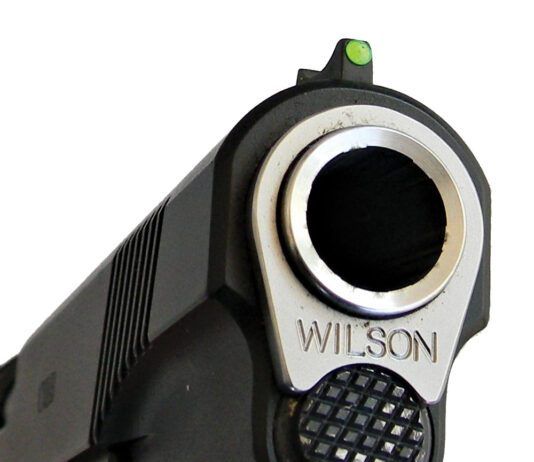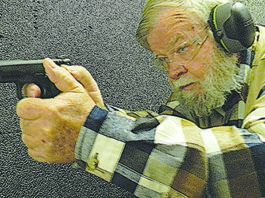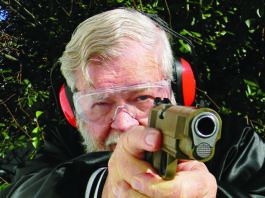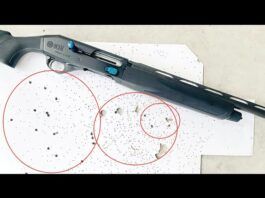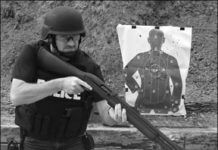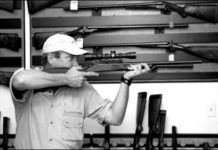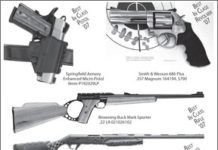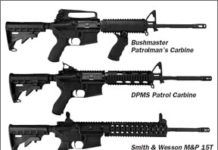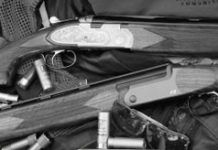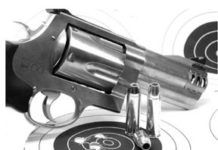Albanian SKS 7.62x39mm
Ruger 77 Mark II .243 Heavy Barrel
New England Arms Handi-Rifle on GunBroker.Com
Buying a Plinker 22 LR? Try the Marlin Model 60
New England Firearms Sportster SS1-217 .17 Mach 2
As of November 2000 the company names and assets attached to New England Firearms and Harrington & Richardson became the property of Marlin Firearms. This makes Marlin Firearms, marketing its products under the brand names of Harrington & Richardson and New England Firearms, H&R 1871 LLC, the largest manufacturer of single-shot shotgun and rifles in the world.
Our NEF rifle was about as simple to operate as any rifle can be, but it did have some up-to-date features. The black synthetic stock was backed by a thick ventilated rubber pad. The comb met the shooter’s cheek with a Monte Carlo–style contour. A pebble finish covered its entire surface. We found the grip end of the stock mated flush to the right-hand side of the flat-black colored receiver, but the left-hand side was slightly offset.
The Surgical Tactical Option: Remingtons 11-87 Police Gun
.17 Mach 2s: New England Firearms Sportster Is An Affordable Blast to Shoot
If the last time you tuned in to the world of rimfire ammunition the .17 Hornady Magnum Rimfire (HMR) was all the rage, then you probably missed the arrival of Hornady's .17 Mach 2 cartridge. The year was 2004, and the difference between the two rounds is this. Just as the .17 HMR can be described as being descended from the .22 Magnum, the .17M2 is related to the .22 Long Rifle—the .17M2 is based on the .22 LR case, slightly lengthened and necked down to .17 caliber. Photographed close up, the .17M2 looks remarkably like a full-size centerfire round, but it's nearly small enough to be hidden beneath a quarter. The .17M2 round does not develop the velocity of .17 HMR ammunition (by about 350 fps on average), but it still offers a very flat trajectory and the advantage of the modern .17 caliber bullet is touted as being more accurate than traditional rimfire slugs.
To experience shooting .17 Mach 2 rounds from behind the trigger, we acquired three rifles. They were the $169 New England Firearms Sportster SS1-217, Marlin's $232 917M2, and the $228 Savage Arms Mark II F. The Marlin and Savage Arms rifles were magazine-fed bolt actions, and the NEF worked from a single-shot break-top design.
Each rifle arrived ready for the mounting of a scope, and we tried several in our initial range session. Considering the low cost of our test rifles, we preferred not to choose a scope that cost more than our most expensive model. We lucked out with the $100 Konus Pro 1.5-5X32mm No. 7249 (konusscopes.com). The Konus Pro offered an etched glass-reticle that gave us plenty of light, and it featured fine crosshairs centered inside of a diamond pattern. We liked this because we didn't want the crosshairs to obscure any more target mass than necessary. In the field we thought the diamond helped us get on target more quickly, and variable power offered added flexibility to our field of view.
We tested with the only three .17M2 rounds we could find. They were Remington's AccuTip V Boat tail, CCI's V-Max and Hornady's V-Max. All three were sold in 50-round boxes and were topped with 17-grain bullets. Prices ranged from $7 for the CCI to $11 for the Hornady in our local store.
Our targets were 6-inch Target Spots by Birchwood Casey. These orange adhesive circles featured a diamond-shaped bull that matched well with the diamond reticle of the Konus Pro scope. Shooting at American Shooting Centers in Houston (amshootcenters.com), we began our benchrest session by recording five-shot groups from a distance of 50 yards with each test round. Next, we tried printing groups from 100 yards with whichever round proved the best in each individual rifle. Each gun was tested under conditions that varied from calm winds and bright sunlight to 25-mph winds that periodically moved clouds in front of the sun. For support, we used a heavy Caldwell Tack Driver bag up front and a bean bag underneath the stock. Here is what we learned.
Gun Tests Guns Of The Year 2007
Compact ARs: The Bushmaster Patrolmans Carbine Is Our Pick
Gun Tests Guns Of The Year 2006
Mid-Grade Sporting Clays Guns: Beretta Versus Blaser/Sigarms
Biggest-Bore Shootout: S&Ws
For those people who want the largest pistol on the block — and perhaps in town — the .500 S&W Magnum is your caliber.According to the Bureau of Alcohol Tobacco, Firearms, and Explosives (BATFE) regulations, rifle and handgun bores are limited to one-half inch, unless the firearm is registered as a destructive device and a Federal $200 tax is paid and all other requirements are met. Translation: Don't plan on seeing .550 or .600 magnum revolvers in the near future. Some other manufacturer could make a longer cartridge, but the overall length on the .500 S&W magnum is already over 2 inches long, and it accommodates bullet weights from light 275-grain hollow points to heavy 400-grain platinum-coated bullets. Such bullets require big launching pads, and we recently acquired two guns that fit the bill, in shorter barrel lengths suitable to uses other than hunting. We acquired Taurus and Smith & Wesson 4-inch-barrel double action revolvers, namely the Taurus Raging Bull .500 Magnum No. 500MSS4, $934; and the Smith & Wesson .500 S&W Magnum No. 163504, $1256. These revolvers generated a lot of interest among shooters. The two most common questions we heard at the range were "Can I have a shot?" and "What do you use that revolver for?" We were more than happy to let a variety of shooters, ranging from teenagers to senior citizens, try out these guns, and we noted their impressions. However, we couldn't talk any women into shooting these monsters. Also, very few shooters wanted to take a second shot.
Our favorite answer to the second question was to say we'd use the guns for "concealed-carry self-defense," then we would all laugh. Of course we don't recommend these guns for concealed carry because of their large size and deep penetrating power. As witness to their punch, we handloaded the lightest bullet (Barnes X 275-grain XPB) with the lightest powder charge recommended (11.0 grains of Hodgdon Titegroup) and fired it into 1-gallon containers of water. Our load produced a velocity of 1,000 fps (400 fps less than Cor-Bon) and a muzzle energy of 600 foot-pounds (half the power of Cor-Bon's 1200 foot-pounds). This was the most comfortable and easily controlled load of all the ones we tested. The most recoil-sensitive shooters had no problem shooting this load.
All that in consideration, we recovered the bullet from inside the sixth jug, which equates to 33 inches of penetration, far exceeding our recommendation of 12 inches. The recovered bullet did not expand or lose any weight. Some people feel that this gun would be suited for bear defense, and based on what we experienced, that seems about right.
If you think the .500 S&W Magnum is simply a larger version of the .44 Magnum round you would be mistaken. The cartridge overall length (COL) of the .44 Magnum is 1.6 inches, whereas the COL of the .500 S&W Magnum is 2.085 inches. The muzzle energy is substantially different. Winchester's most potent load for the .44 Magnum is a 250-grain platinum-tip hollowpoint (#816160, $20.49 for 20 rounds) which has a listed velocity of 1250 fps and muzzle energy of 867 foot-pounds. Winchester's .500 S&W Magnum 400-grain platinum-tip hollow point (#361538, $40.49 for 20 rounds) has a listed velocity of 1800 fps and muzzle energy of 2877 foot-pounds — more than three times the energy of the .44 Magnum! The listed velocities were based on revolvers with 8-inch barrels. Our recorded velocities were approximately 300 to 400 fps less with 4-inch barrels.
Here's what we learned:

























